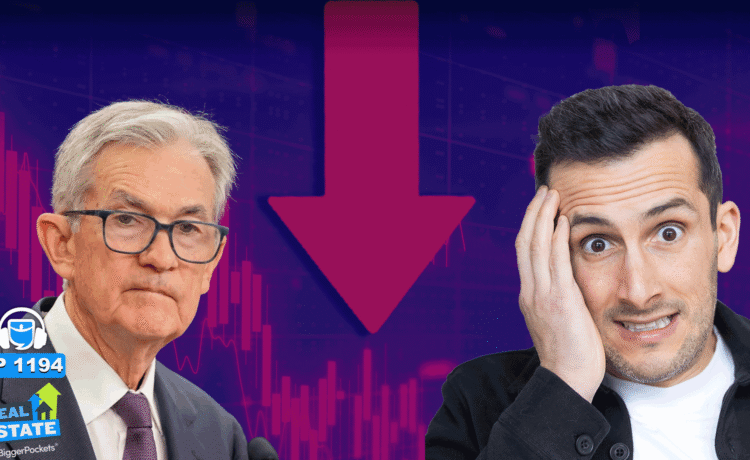The Federal Reserve just cut rates by another 0.25%, but mortgage rates went…up? This is now the fourth time the Fed has lowered its federal funds rate, and mortgage rates have defied them. It’s becoming clearer than ever before: real estate investors cannot rely on the Fed to save them.
If you’re waiting for mortgage rates to get back in the mid-to-low 5% range, you might be waiting for a while. But you don’t have to. Dave (and the guests on this show) are actively buying real estate deals, building their portfolios, and increasing their cash flow, all while interest rates are high. You can do it too—no matter what the Fed decides. In fact, right now may be a low-rate period that future investors will wish they could return to.
There are six things you can do right now to lock in great real estate deals, even with rates rising higher. This is the opportunity for investors. Average homebuyers are sitting on the sidelines, many investors are still scared to jump back in, all while sellers are lowering prices, offering concessions, and willing to negotiate. You wanted a time to get better deals? This is it, and the Fed’s moves are only giving you more control.
Dave:
The fed cut rates on Wednesday and mortgage rates went up. So what gives, hasn’t every person on the internet been saying that there will be lower mortgage rates because the Fed will cut rates? Well, haven’t I’ve been saying mortgage rates aren’t moving that much and that hoping the Fed will make investing easier is not a viable strategy for 2026. So today I’ll make this confusing situation make sense underneath all this noise about fed rates, about mortgage rates and home prices, there is opportunity for investors. Let’s unpack. Hey everyone, welcome to the BiggerPockets podcast. I’m Dave Meyer. Thank you for joining us on the show today. We have a good episode here for you. In today’s episode, I will talk briefly about what happened this week with the Fed and why my thesis about rates has been right so far, but we’re going to focus more on how to invest in an environment where rates might not be coming down.
So first and foremost, I just got to say this, I get it. I know that people want mortgage rates to come down. I know that they want homes to be more affordable. I want homes to be more affordable too, and I get that people have been eyeing fed rate cuts as these magical periods where all of a sudden things are going to get easier. But hopefully now you see that that is not the case four times in a row. Now when we have the fed cut, the federal funds rate, we’ve actually seen mortgage rates go up. Now they’ve gone down leading up to those decisions, but hopefully you could see that these events, these magical days don’t actually exist. And I know that can seem confusing because there are a lot of counter narratives out there about how the Fed is going to push down mortgage rates and then it doesn’t happen.
So I get that that can be really confusing. But if you listen to the show, I’ve been saying this would happen all year because people who actually study the housing market knew that this was a relatively likely scenario. So we’re going to talk about that today, why rates haven’t really budged and why it might not happen for a while. But I think focusing solely on rates in this episode is a mistake. It’s important, but people are sort of obsessing over the wrong things. Instead, people should be focused not just on rates, but other fundamentals and how to invest even in this higher rate environment that we’re in. People in my opinion, should be focused on finding great markets, taking advantage of the better inventory levels that we have, using their leverage to negotiate great deals, positioning themselves for long-term growth because people have been investing in real estate for decades, for centuries really, and rates do what they do, but the real investors, they find ways to make it work regardless of the rate environment.
And in today’s episode, you’re going to learn to do the same thing. Alright, so first let’s talk about what actually happened. They cut the federal funds rate 25 basis points on Wednesday the 29th of October. 25 basis points just basically means 0.25 percentage points, so a quarter of a percentage point, and this is basically a foregone conclusion. There are actually markets where people bet on this stuff and it was actually like a hundred percent odds that this was going to happen. So this was not a surprise at all. And with that, we saw all these people on social media and honestly in some of the regular media too, pointing to lower mortgage rates. But unfortunately those people don’t understand how this work, and that’s okay. It is kind of complicated, but let me explain to you how this actually works. The Federal Reserve controls one interest rate and this does influence other borrowing costs, but what it impacts is short-term borrowing costs.
In the world of finance mortgages, the things that we as real estate investors care about are long-term borrowing. These are long-term loans and long-term loans are less influenced by the federal funds rate. Sometimes they do move together, other times they don’t. Like in the last couple of years they are loosely correlated, but that correlation has been weakening over the last couple of years. But there is something that we can track if we want to understand mortgage rates and those are yields on the 10 year US Treasury. That’s why I talk about this. If you listen to our sister show on the market, we talk about this a lot and I should mention if you like this kind of nerdy stuff where we dig into how these things really work. Check out on the market. We talk about this all the time, but it’ll give you a high level overview, which is basically that the yield on a 10 year US treasury is controlled by bond investors who are very different from real estate investors.
These are people who manage pension funds or hedge funds or sovereign wealth funds or family offices. Huge amounts of money. And what really moves the bond market are fears of recession and fears of inflation. When people are generally afraid of recessions, they put their money into bonds and that lowers bond yields and takes mortgage rates down with them. When people are afraid of inflation, they demand a higher rate on bonds to lend money to the government and that pushes bond yields and mortgage rates up. What’s so frustrating, what’s making this so hard for the housing market is that both of these things, inflation and recession are riskier than usual. Right now, in a normal market, you’re usually afraid of one or the other. If you’re in a really good economy, you’re kind of worried about inflation, things getting too hot. If you’re in a bad economy, you’re worried about a recession, things getting too cold.
But it is unusual to be in the situation that we’re in right now where there is fear of both. You have fear on both sides of the market and that is sort of locked in bond yields. In a way, the bond market is a bit stalled. It’s kind of like having this tug war where half of bond investors are really worried about a recession and then the other half are really worried about inflation and they’re pulling against each other and no one is going anywhere that’s going on in the mortgage market right now. So despite what happens with the federal funds rate, bonds just aren’t moving that much and that’s why mortgage rates aren’t moving as well. So yes, we got a rate cut from the Fed that should actually help commercial real estate a little bit more tied to short-term lending. But in the residential market, for the majority of our investors here, the BP community are buying one to four unit properties.
It’s not going to mean lower mortgage rates, at least right now. And just remember as we get more rate cuts in the next year or so, I do think we’ll get more rate cuts. That does not mean more mortgage rate declines and you cannot count on that happening. I think that’s the big takeaway right now is that no matter what the Fed does, it doesn’t equate to better investing conditions for us. And so what we need to do is look at the conditions on the ground today and figure out how to optimize for the existing market, the existing rate environment, and still make good investments because that is absolutely possible unless you’re getting distracted by the rates. So let’s not get distracted by the rates. Let’s not wait around for something that is completely out of our control. We got to take these things into our own hands.
That’s what I’m going to do. I know people do want to know what’s going to happen with rates. I will just say that for the rest of 2025, I’m expecting things to be pretty similar to what we’ve seen recently. Probably low to mid sixes we might see unless we see some big change, if we see some huge change in the labor market, if we see some huge change in inflation data, then mortgage rates could actually move. But that’s going to be pretty difficult, right? Because the government is shut down. So we don’t even have inflation data. We’re not even getting half the labor market data that we normally get. So it’d be pretty hard for those things to move in any direction when we just don’t have reporting on it. So most likely we’re stuck with mortgage rates through the end of the year. I will be giving a forecast on mortgage rates for 2026 in a couple of weeks, but as of today, I don’t see much changing in the next year.
Which brings us to our main topic for today. How do you invest in a higher rate environment? We’re going to get into that on a very strategic level. So not big picture, but also on a super tactical level of the things that you could be doing each and every day to build a better portfolio even in a higher rate environment. And we’re going to do that right after this break. Stick with us. This week’s bigger News is brought to you by the Fundrise Flagship Fund. Invest in private market real estate with the Fundrise Flagship fund. Check out fundrise.com/pockets to learn more.
Welcome to the BiggerPockets podcast. I’m Dave Meyer. Thank you all so much for being here. I’m excited about this episode. I feel like for years now, the whole real estate investing community was talking about lower rates, lower rates, lower rates, and I wish they were lower. I wish things were more affordable, but I’m hoping that by now people are seeing that the Fed is not coming to save us, and that means we have to do the work of figuring out how to make our portfolios work in a higher rate environment and that is absolutely possible. So I am excited to talk about this. I think by the end of this episode, you’re all going to see the opportunities that lie in front of us. Now I want to sort of break down the rate thing and why people are so sort of obsessed with it right now.
Rates matter because they are a critical function of affordability. That is the thing that is holding up the housing market right now. It is why we have low transaction volume. It’s why we’re shifting from a seller’s market to a buyer’s market is because things just aren’t affordable. But rates aren’t the only function of affordability. They’re one of three sort of big variables that go into the affordability of a home. You also have home prices of course, and you have wages, basically how much people are earning. And those three things combine are what make up housing affordability. Now, I’m going to say something that is probably going to surprise most people, but housing affordability has actually been improving just for the last couple of months, not for a long period of time. I think it’s like three or four months in a row now, and not by huge numbers, but even though mortgage rates haven’t moved down in the way that a lot of people wanted or were expecting, we are still seeing improvements in affordability.
This comes from a combination of these three variables, right? We’re getting slightly lower rates, actually more than slightly in January. Mortgage rates are at about 7.1 right now as of today, a day after the rate cut, we are at 6.25, so that’s 0.9, right? Almost a full percentage point lower. So they’ve actually come down. That really does matter with cashflow and affordability. The next thing is we have higher wages than we did a year ago. They’ve been growing faster than the pace of inflation, faster than the pace of appreciation in most markets that makes homes more affordable. And then on a national level, we have pretty stagnant or correcting prices. Some markets are down, some are up, but on a national level, we’re seeing prices pretty darn close to flat. And if you look at them in inflation adjusted terms, they’re down about 2% from the peak that they were at in 2022.
Looking at all those things together, that means we’re actually getting better affordability. So this even without the lower rates people wanted from this fed rate cut is a good sign for the housing market. And personally, I think for at least the next six months or so, we’ll have to see what happens after that. I think affordability is going to improve. Wage growth is still up a little bit. I’m a little worried about that with AI and the state of the labor market, but I do expect prices to decline modestly for at least the next couple of months. And although mortgage rates could go up a little bit, I doubt they’re going to go up a lot. And so I think we’re going to at least stagnant affordability or modestly improving affordability. That might not sound exciting, but that’s after what 5, 6, 7 years of affordability declining.
This is a good improvement. I know some people want it to happen all at once. Personally, I don’t. I think we need to get back to better affordability, but I’d rather have that gradually. So there’s not a lot of pain in the housing market and that is starting. We don’t know if it’ll continue for how long, but the signs and the data are there right now, and to me that is pretty encouraging. But I am talking a lot about affordability. I think it’s sort of the key to our investing strategy. I’m talking now about how to make things work, how to build a successful portfolio in a higher rate environment and affordability is sort of the key to investing right now. At least that’s been my hypothesis, my thesis about investing over the last three years and I’m sticking with it because it’s been working for me.
So yeah, things are getting a little bit more affordable, but on a broad high level, it’s not going to improve that much. And that does create challenges for investors. That does mean it’s harder to get in, but it also means that we are entering a buyer’s market. And who does that favor? Buyers or investors? So this is the key thing I want people to remember is there are trade-offs in every single market. The high rate environment that we’re in right now, the trade-off is that things are more expensive and that is a real challenge, but it also means that you’re going to have more leverage. You’re going to be able to buy assets at a discount, you’re going to be able to be patient, you’re going to be able to get concessions from sellers. These are things that are absolutely in your favor. And so you just need to think about in that high rate environment, what is the market giving me?
What are the advantages I have as an investor in this higher rate environment? Because there’s never a perfect market ever. It doesn’t exist. And so right now we’re in just like every market, one with trade-offs and the trade-offs are between, yes, things are less affordable, but have all these other things that I can be taking advantage of and those are the things you must take advantage of in order to be successful in this environment. So how do you invest in this higher environment? What are the literal steps that you should be doing, the tactics that you should be employing? Step number one, you got to leverage what the market is giving you. You can’t just wait around for market conditions to return to 2021. It’s not going to happen. I’ve been saying this for years and I’ve been right. It’s not going to happen everyone.
Instead, you got to adjust to what the market is today and think critically about how you can take advantage of the conditions the market is presenting to you. What does that mean? I said it before. Negotiating leverage. This means you can be very patient, you can choose the deals, be very surgical with the kind of deals that you’re looking for, and be really patient and really disciplined about only buying at the right price and getting the right on your deal. Next, look for great assets at better prices. You always want to do this. Everyone wants to buy prices at a discount. Everyone wants the place in a great neighborhood. You couldn’t do that in 2021. It was super hard. You could not negotiate. You were buying whatever came on the market. And yeah, that worked out for some people, but it was really hard too.
In other ways, deal flow was bad. The opposite is going to happen in this higher rate environment. We are going to get better deal flow, which means we can get better assets at better prices, and that’s what you need to be focusing on. The other thing that I think is going to happen, maybe not in the next six months, maybe not in the next year, but over the next two to five years, cashflow prospects I do think are going to get better. I expect I’ve talked about this before, that we’re going into a great stall where prices are going to be flat or modestly declining. Rent growth is pretty flat right now, but even during big corrections, even during the great recession when prices declined a lot, rent stayed sort of flat. And if that happens again, prices go down, rents stay flat. That means better cash flow if prices go down and rents go up, and I do think there is a decent chance that happens, that means much better cash flow prospects.
So look for those opportunities to find great cashflow in a market that’s offering potentially better cashflow than we’ve seen over the last couple of years. That’s step one is really focusing in on what the market is giving you. That is the mindset that you need to take into this high rate environment. Don’t see high rates as your enemy or something. You have to battle. See it as just a shift and an adjustment that you need to make. Step two here is about affordability. Remember I talked about, and you’re probably tired of hearing me talking about affordability. I really just think it drives everything in the housing market. And although I said I don’t think affordability is improving much on a national level quickly, I think it will get better over time, but it’s going to take a little while. I think that relative affordability is extremely important.
Now, let me explain what I mean by that. In any given city, there are areas that are more affordable than other areas. In any given state, there are certain cities that are more affordable than others, and I believe that areas that are affordable to the average person in that area, whether to people who are homeowners and home buyers or people who are renters are going to perform the best over the next couple of years, I think they’re going to be more insulated against downside risk than other places. I think when things turn around and start heating up again, they’re going to heat up the quickest. And so for me, I am always looking for relative affordability. Think about it this way. Could the average person living in this neighborhood or within this radius of this house afford this home? And if the answer is yes, you’re going to find that it is more insulated against any downside risk and probably has better long-term upside because pricing in a home or for your rents are all a function of demand.
And demand comes from people being able to afford the product that you’re putting out there. So yeah, you can make tons of money in luxury stuff, but there’s going to be less demand for that. There’s going to be less people who can afford the luxury stuff. You can still make money that way, but when you buy affordable stuff, that’s sort of the most people can afford that product and that’s going to have the most demand that’s going to push up prices. That’s just how supply and demand work. So think about that in your neighborhood. We got to take one more quick break. Stick with us.
Welcome back to the BiggerPockets podcast. I’m Dave Meyer here talking about the things that you should do or at least the things that I’m doing, and I recommend to a lot of people that you should be doing to be successful in a higher rate environment. I’m tired of people saying that you can’t succeed in a higher rate environment. You can. You just need to adjust your strategy and here are the ways that I think make sense to adjust your strategy and your portfolio plan going into 2026. Step number three, and maybe this should have been step number one given the context of this episode, but underwrite using today’s rates. That is something I really want to stress. Do not count on cuts. Don’t even count on a refinance unless you’re doing a burr. If you’re doing a burr and you’re going to build equity, you’re going to force equity.
That’s okay. You can absolutely count on that kind of refinance, but do not buy a property saying, oh my God, it’s only getting 1% cashflow today, but if rates go down, it’s going to be 6% cashflow. Don’t do that. Or you might be doing that. That’s fine if you’re okay with that 1% cashflow, but do not assume that rates are going to come down and that’s magically going to make your deals better. That is just wishful thinking. That is not a strategy. That is not good investing. That is just speculating. The good thing is you don’t need to do that. You can find deals that work using today’s rates, so absolutely do that. That is step number three. You got to underwrite using today’s rates. Step number four. This is a big thing that I’ve been harping on all year, but you got to protect against downside risk.
I would call this underwriting scared. I think you need to assume not worst case scenarios. I’m not underwriting deals projecting that we’re going into 2008. That to me is a little bit dramatic. There is really no data that suggests that that’s happening, but I am underwriting assuming that I am not going to get appreciation for the next two years. At least maybe I will, but I just don’t think it makes sense to underwrite with that assumption. I’m also not assuming that rents are going to grow, and I’m also assuming that vacancy is going to go up. I don’t know if we’re going to a recession. I don’t even know what that word means anymore, but we are seeing weakening of the labor market. That means vacancies could go up, it means rent growth could stall out for a while. It means appreciation could stall out for a while.
I know all these things sound scary, but you could still do good deals in this kind of environment if you plan for it, so plan for it. That’s where the underwriting comes in. When you’re analyzing your deals, that’s where you mitigate risk. You put it into your assumptions that you’re not going to get appreciation, that you’re not going to get rent growth, that you’re going to have higher vacancy, and if the numbers still work with that and today’s mortgage rates, those are the deals you buy, and I know that means that you’re going to have to say no to a lot of deals. Good say no to a lot of deals right now. That is absolutely what you want to do. The whole goal here is to get great low risk assets during a time when fewer people are competing. You’re going to be able to find great assets, but you’re going to have to sift through a lot of garbage to get it.
That’s the job of an investor. If you are expecting to go out, just be able to underwrite deals and write offers on most of them, you’re going to be disappointed. That is not the right mindset to have. What you need to be thinking about is how do I find that one in 50 property, right? That’s what you should be looking for, and you should take that as a point of pride, right? I know it’s frustrating to have to look at 50 deals, but when you go and buy that, you’re going to feel good about yourself. You’re going to think, wow, I did the hard work to find the best deal on the market in my city. For me, that’s a good feeling. That is better than just being like, oh, I just went on Zillow. I clicked a button and I bought something. So that is the whole point of this underwrite scared.
Make sure that you are finding the best possible deal for yourself because you can right now. That’s something that you can take advantage of. There are good deals out there. Go find them. That’s step number four. Step number five is targeting upsides. We’ve been talking about this all year, the upside era and how you can mitigate risk and still get great returns. You underwrite scared. That’s the way you protect yourself against downside risk, but the way you get the big benefits from real estate is targeting those upsides. These are things like zoning, value add, owner occupancy. These are all things that can take these deals that are very safe. They are offer good risk adjusted returns and make them into amazing risk adjusted returns. Zoning, as an example, look for ADUs, the ability to add a lock off and add a second unit to develop something in the backyard.
Value add. This is just real estate investing 1 0 1. How do you find a property that’s not up to its highest and best use? Bring it to its highest and best use and get paid for it. That’s value add investing owner occupancy works in the short run. Rent is still super expensive. Can you lower your living expenses by buying a great asset during this kind of market? That’s amazing. That’s a great way to have a ton of upside in your deals. So step number five is targeting that upside. Now, step number six. The last one here is a little bit nerdy, but I really want y’all to think about using fixed rate debt. Now, this is sort of tactical and in the weeds, but I really think this is important right now, and I’m sorry if this sounds like being a downer, but I actually think there’s a chance that mortgage rates will be higher in five years than they are today.
I’m not trying to discourage you. I’m trying to prepare you for this. I want to tell you what frankly, a lot of other people in this industry are refusing to say with our national debt, with a lot of what’s going on, the likelihood of higher rates is sort of getting bigger and bigger every year. Now, obviously, I don’t know for sure there so much is going to change in the next five years, but I’m just saying that there’s a chance that in five years people will be talking about how they wish they had locked in that 6% mortgage. Of course, things could go the other way. In that case, you can always refinance, but I do really feel most people should consider only doing deals with fixed rate debt right now. I think it makes a lot of sense. Also, I just want to call out to people that everyone loves seller financing these days, right?
Oh yeah. You get seller financing, you get a lower rate Sometimes that is true, but most seller financing deals, the seller is not willing to carry a 30 year note. They’re not giving you a 30 year fixed rate debt like the bank. They might not be alive in 30 years, so a lot of times what they do is they say, I’ll give you seller financing for the first five years, and then you have a balloon payment. Then you have to refinance. This is also a form of variable rate debt because you are going to have to refinance that deal. I’m not saying that you can’t do it, I’m just saying be cognizant of that and watch mortgage rates closely if you’re doing that, because again, in five or 10 years, we just don’t know. And so the idea that you could buy something and have to refinance your rate up, that’s dangerous.
That’s tanked multifamily over the last couple of years. That’s what’s tanked retail in office. That’s why prices in those markets are down 20, 40% depending on the asset class. I don’t want that to happen to anyone here, and I’m not saying that it’s definite, but you can protect yourself against this by locking in fixed rate debt, and if you have that opportunity, I would take it. So that’s what we got today, guys. I know that a lot of people are going to be celebrating the Fed rate cut saying, oh my God, this is some magical turning point in the housing market. I think it’s the opposite. I think we need to be saying, okay, we’re in a higher rate environment and that’s okay. That’s fine. We’re going to work around this because investors have been working around mortgage rates much higher than this, and hopefully you can see that there are tons of things that are actually in your control that can positively impact your portfolio about the environment that we’re in.
There are ways to make money. There are ways to do good deals. There are ways to pursue financial freedom in a good risk adjusted way, even in a higher rate environment. I gave you some of the steps that I’m following, but if you have your own thoughts, share them with us. Share them with the BiggerPockets community. That’s what being a part of a community like BiggerPockets is all about. Go on the forums and share your ideas. Share them in the comments below. If you’re watching on YouTube, share them with us on Instagram. We would love to hear how you’re navigating the higher mortgage rate environment so we can all share these ideas and learn together. Thank you all so much for being part of the BiggerPockets community and for listening to this episode. I’m Dave Meyer. We’ll see you next time.
Help us reach new listeners on iTunes by leaving us a rating and review! It takes just 30 seconds and instructions can be found here. Thanks! We really appreciate it!
Interested in learning more about today’s sponsors or becoming a BiggerPockets partner yourself? Email [email protected].








Recent Comments